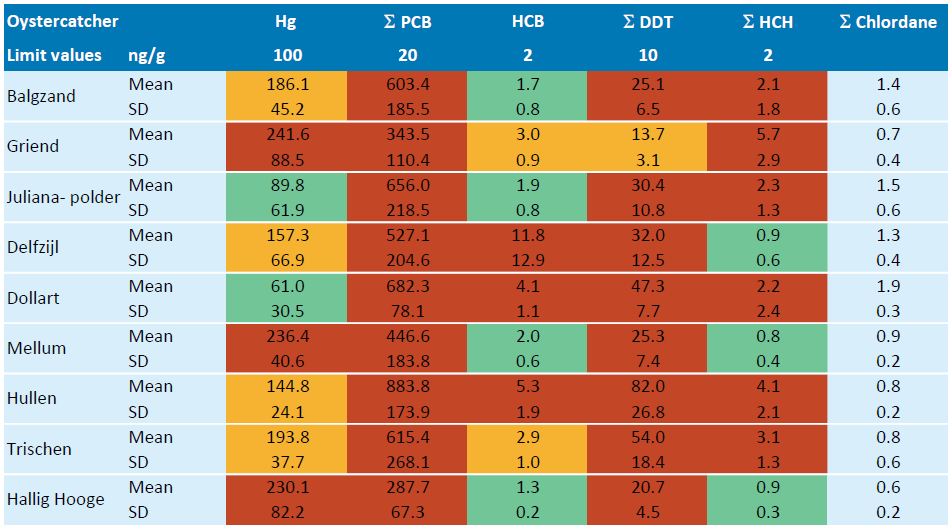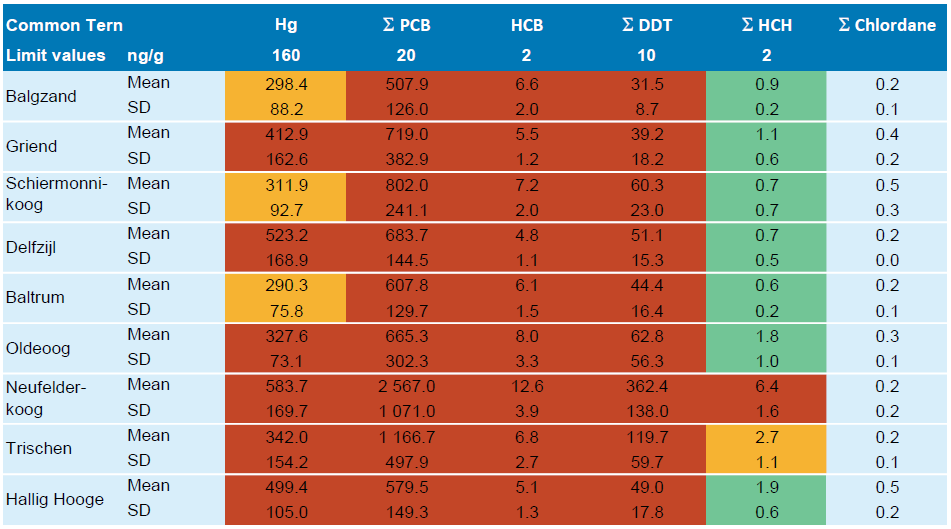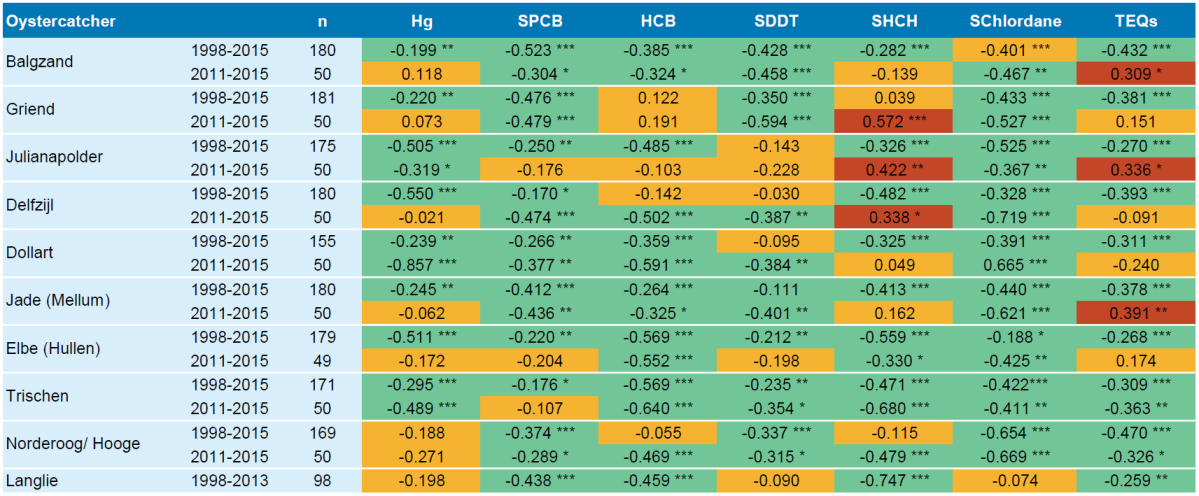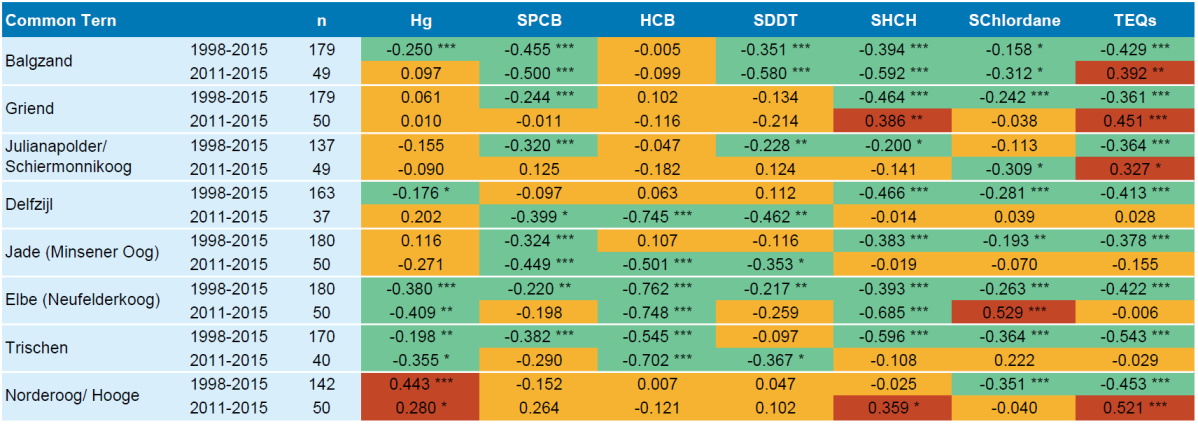Photo: Tore Mayland-Quellhorst. Oystercatcher eggs on Trischen.
Contaminants in bird eggs
F. R. Mattig
PDF1. Introduction
Monitoring of coastal bird eggs has proven to be an excellent method for monitoring chemical pollution as the eggs indicate local pollution, and in the long term reveal temporal trends in the contamination of reproductive females and by extension of the environment. Since 1981, monitoring of seabird eggs along the German Wadden Sea coast has been carried out by the Institute of Avian Research with the aim of assessing environmental pollution by anthropogenic contaminants such as mercury and organochlorines (Becker et al., 1992). Since 1998, the parameter “Contaminants in Bird Eggs” has been incorporated into the Trilateral Monitoring and Assessment Program (TMAP; Becker et al., 2001). As top predators of the food chain in the Wadden Sea, the common tern (Sterna hirundo) and the oystercatcher (Haematopus ostralegus) were chosen as indicator species (Figure 2). Due to their different feeding ecology – common terns feed on small pelagic fish and crustaceans whereas oystercatchers prefer mussels and worms - the diet of these two species represents major parts of the Wadden Sea ecosystem. In the spring of each year eggs of these two species were collected at a total of 16 breeding sites across the whole Wadden Sea (Figure 1). In these eggs concentrations of mercury and organochlorines, including industrial chemicals like polychlorinated biphenyls (ΣPCB) and hexachlorobenzene (HCB) as well as toxic pesticides like dichlorodiphenyltrichloroethane (ΣDDT) and hexachlorocyclohexane (ΣHCH), were determined (see Annex for details).
This report provides an update of the information presented in the 2009 QSR. One focus is the geographical variation of bird egg contamination within the Wadden Sea in 2015 (see chapters “Spatial trends in oystercatcher” and “Spatial trends in common tern”). Another focus is on temporal trends. The data were separated into three periods: i.e. a short-term period covering the last five years (2011-2015), a medium-term period including all data of the running TMAP-project (1998-2015) and a long-term period of 34 years including data previously collected in the context of TMAP (1981-2015).
Figure 1. Annual sampling sites of common tern and oystercatcher eggs analysed for contaminants since 1998. The Netherlands: 1 Balgzand, 2 Griend, 3 Julianapolder, 4 Schiermonnikoog, 5 Delfzijl; Germany, Niedersachsen: 6 Dollart, 7 Baltrum, 8 Minsener Oog, 9 Mellum (8 + 9 = Jade Bay), 10 Hullen; Germany, Schleswig-Holstein: 11 Neufelderkoog (10 + 11 = Elbe estuary), 12 Trischen, 13 Norderoog (until 2006), 14 Hallig Hooge (since 2007); Denmark: 15 Margarethenkoog; 16 Langlie. At the sites 4 (since 2005), 7, 11 and 15 only common tern eggs were collected, at the sites 3 (since 2005), 6, 7, 9 and 16 only oystercatcher eggs were taken; at sites 1, 2, 3 (until 2004), 5, 12 and 13/14 eggs of both species were sampled.
The results show that in most cases the eggs of oystercatcher had a lower contamination level oystercatcher than those of the common tern eggs, due to the higher trophic level of the fish-eating terns. In all years the Elbe estuary was the area most affected by pollutants, carried by the river. The temporal trends for 1981-2015 show a clear decrease in the contaminant levels, mainly during the early 1990s, due to changes in the industrial sector caused by the German reunification. Concentrations of many contaminants are still at a high level, but below the values known to affect bird reproduction (Muñoz Cifuentes, 2004). Nowhere are the Ecological Quality Objectives (EcoQOs) defined by OSPAR for coastal bird eggs from the North Sea area (Dittmann et al., 2012) close to being fulfilled. For the eggs of the common tern the OSPAR limits of Hg (160 ng/g), PCB (20 ng/g), HCB (2 ng/g) and DDT (10 ng/g) were exceeded at all investigated areas in 2015. For the oystercatcher eggs the values were below the limits of Hg (100 ng/g) at two places only, while this was the case for HCH (2 ng/g) and HCB (2 ng/g) at three sites each. However, the results for PCB (20 ng/g) and DDT (10 ng/g) exceeded the EcoQO levels at all places.
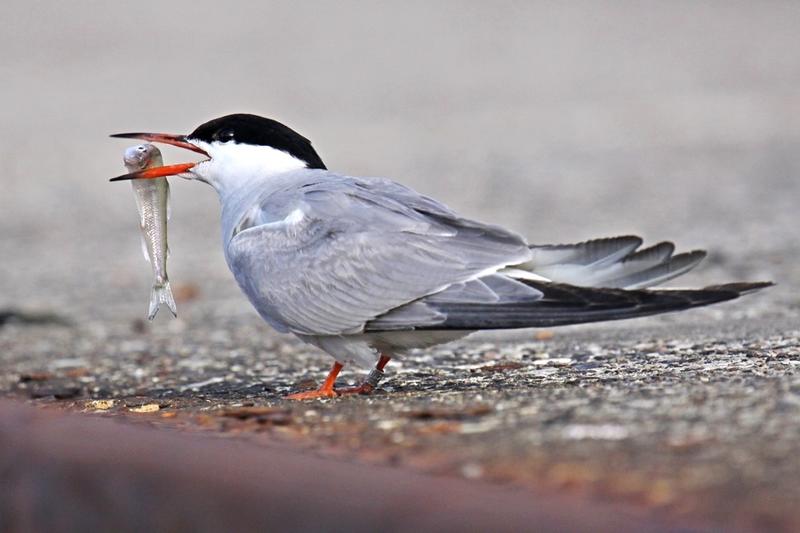
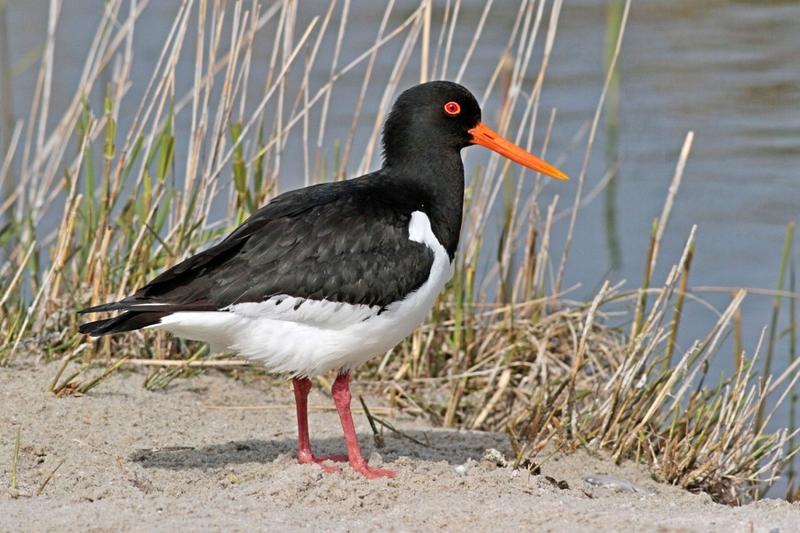 Figure 2. Left (A): Common tern; Right (B): Oystercatcher (Photos: R. Nagel).
Figure 2. Left (A): Common tern; Right (B): Oystercatcher (Photos: R. Nagel).
2. Status and trends
Spatial trends in oystercatcher
In 2015 the concentrations of the mentioned substances in oystercatcher eggs showed only small geographical differences. The highest levels of PCB and DDT were detected at the Elbe while HCH reached highest levels at Griend. Conspicuous were the HCB concentrations in oystercatcher eggs at Delfzijl, which were two to nine times higher compared to other sites in the Wadden Sea. This concentration peak has been observed for many years and may be caused by contaminated water and sediment from the Sea Harbour Channel in Delfzijl (Eggens & Bakker, 2001). During the period from 2008-2012 (see TMAP reports 2011 and 2012) increasing concentrations were evident after the HCB concentration had decreased until 2000 (Eggens & Bakker, 2001). After an increase in 2014 the concentrations in 2015 were clearly lower compared to the previous year and reached the level of 2008/2009 (Figure 4B, midterm trends 1998-2015). Compared to 2014 the measured concentrations were slightly lower in the case of PCB, DDT, HCH and Chlordanes, but tended to be higher for Hg. Concerning HCB the measured concentrations were up to three times lower compared to the year before, also at Delfzijl. However, the measured concentrations of the dioxin like PCB congeners (TEQ) were highest there in 2015 (for more details see chapter “TEQs”).
Table 1. Mean concentrations in ng/g (fresh mass of egg content) and standard deviations (SD) of environmental chemicals analyzed in oystercatcher and common tern eggs in 2015. For each species ten eggs are sampled per site. Green indicates the undercut of the limit value defined by OSPAR for coastal bird eggs from the North Sea area (Ecological Quality Objectives (EcoQOs), ICES 2003, 2004; OSPAR, 2007; Dittmann et al., 2012. Species-specific limit values for the different substances are shown in the header of the table. Mean concentrations up to twice times the limit value are marked in yellow and mean concentrations that exceeded the limit value more than twice are marked in red. For chlordane no limit values have been defined up to now.
 Figure 3. Geographical variation of the contaminants analysed in common tern and oystercatcher eggs in the Wadden Sea in 2015. Mean concentration (ng/g fresh weight of egg content) and 95 % confidence intervals of ten sampled eggs per species and site are presented.
Figure 3. Geographical variation of the contaminants analysed in common tern and oystercatcher eggs in the Wadden Sea in 2015. Mean concentration (ng/g fresh weight of egg content) and 95 % confidence intervals of ten sampled eggs per species and site are presented.
Spatial trends in common tern
In 2015 prominent concentration peaks of Hg, PCB, DDT, HCB, HCH and also the TEQs were found in the common tern again at the Elbe estuary. Subsequently, a continuous decrease of pollution was recorded with increasing distance from the Elbe estuary, which tallies with the observations from previous years. The second highest levels were found mostly at Trischen, as the area is influenced most by the water of the Elbe. But in 2015 high HCB concentrations were also found in the western areas of the Wadden Sea. Different from 2014, there were strikingly increased geographical differences of the Hg concentrations in common tern eggs, but without a clear pattern. High Hg concentrations were observed not only at the Elbe or surroundings areas but also at Griend, Delfzijl and the Halligen. The average level of 400 ng/g Hg over all investigated areas of the Wadden Sea was clearly higher than in 2014. Compared to other contaminants, a lower influence of HCB was recorded at the Elbe. The concentration showed only small geographical differences and tended to reach a level of approximately 7 ng/g fresh weight which is clearly lower compared to 2014, but clearly higher compared to oystercatcher eggs. For Hg and PCB the concentrations in common tern eggs tended to be higher in 2015 than in 2014, whereas for DDT and HCH they were similar.
Reflection of spatial trends in both species
In general, the species-specific spatial contamination patterns in 2015 remained similar to those recorded in 2014 and the previous years. The contamination pattern for the common tern again showed clear concentration peaks at the Elbe. By contrast, the contamination pattern for the oystercatcher was inconsistent, showing different geographical peaks for each substance. The species-specific patterns may have been influenced by differences in the feeding ecology, with the oystercatcher possibly foraging to a higher degree in terrestrial habitats at some of the investigated sites. This might explain why in particular at the Elbe, no maximum concentrations were found in the oystercatcher whereas this was the case for the common tern. Furthermore, for the oystercatcher, which is a benthic feeder, contaminants bound to sediment particles are probably more important than for the common tern, which is a pelagic feeder. In addition, the fact that some oystercatchers are present in the Wadden Sea during the whole year might have affected the contamination patterns recorded. In general, the data underline the importance of the large rivers Elbe and Ems for the influx of several contaminants into the Wadden Sea. For Hg, PCB, HCB and DDT, contamination levels tended to be higher in the common tern than in the oystercatcher (except for HCB at Delfzijl), reflecting the higher trophic level of the piscivorous common tern with an even more effective bioaccumulation of pollutants. However, at most study sites chlordane concentrations were clearly higher in oystercatcher eggs than in common tern eggs.
In the past, the influx of Hg into the Wadden Sea took place mainly via the rivers, especially via the Elbe. But in recent years we have seen a reduced impact of the rivers for the Hg influx. In 2015 for both species a distinct source for Hg into the Wadden Sea was not visible. The Hg levels tended to be higher in the common tern than in the oystercatcher, reflecting the higher trophic level. But there was no geographical difference in the Hg concentrations and for both species there was an established level of Hg in all investigated areas of the Wadden Sea. The reason for this trend may be the improved water quality of the rivers on the one hand and the continued high Hg input through the atmosphere on the other hand. The most important source of anthropogenic Hg emissions into the atmosphere is coal burning. In 2015 the Hg concentrations in common tern were higher than those in 2014 in all areas and still above the Ecological Quality Objectives (EcoQOs) of 160 ng/g Hg (e.g. Dittmann et al., 2012).
Temporal trends
An overview of medium-term (1998-2015) and short-term (2011-2015) temporal trends of contaminant concentrations is given in Table 2 and in Figure 4.
Although during the five-year-period from 2011-2015 more decreasing than increasing contamination levels of the measured substances were recorded for the two species at the various study sites, in many cases a clear temporal trend could not be established. This made the results difficult to interpret. Remarkable for both species were the significant increases of the TEQs at each of the three sites, which means that the toxicity of the PCB mixture may increase although total PCB concentrations decreased (see chapter “TEQs”).
For each species eggs from nine sites were analysed with respect to five contaminants (45 cases) every year. In oystercatcher eggs decreasing concentrations were detected in 35 cases and most of them were noted at Trischen, Dollart and Halligen. Remarkable were the concentrations of Chlordane, which significantly decreased at all investigated areas. In the case of HCH increases were observed at three of the nine sample sites, mainly in western areas, but HCH also decreased in three areas in the eastern part of the Wadden Sea. In total only three increases in oystercatcher eggs were noted in 2015. In general the decreases or increases measured were mostly only small although sometimes consistent (see Figure 4).
During the period from 2011-2015 decreases in contaminant levels were also more significant than increases in common tern eggs. In total 17 significantly decreased substance levels were found and most of them occurred at Balgzand. Increases were found in HCH at two sites, and in the case of Hg and chlordane at one site each. In total four significant increases in substance levels were found in common tern eggs, primarily at Hallig Hooge (two).
Between 1998 and 2015, nearly all concentrations of environmental chemicals in eggs of both species decreased significantly at most sites (Table 2). In this 17-year period there was no significant increase in any of the measured compounds, except the Hg concentrations in common tern eggs from Hallig Hooge (Table 2). These results suggested stable or sinking contamination levels in these two species in this period.
Figure 4. Left (A): Middle-term (1998-2015) trends of contaminant concentrations in common tern eggs from different sampling sites; Right (B): Mid-term (1998-2015) trends of contaminant concentrations in oystercatcher eggs from different sampling sites. Dots indicate arithmetic means (ng/g fresh weight of egg content) of the sampled eggs.
Table 2. Medium (1998-2015) and short term (2011-2015) trends in pollutant levels and TEQs in common tern and oystercatcher eggs. Spearman rank correlation coefficients (rs) were calculated on the basis of n eggs, and p-values are presented. * < 0,05; ** < 0,01; *** < 0,001. Positive trends are given in bold and marked red whereas negative trends are marked green.
Figure 5 shows the long-term-development of mercury, ΣPCB, HCB and p,p-DDE concentrations at three selected sites in the western (Griend), central (Trischen) and the northern part of the Wadden Sea over a study period of 34 years. During that long period, the contaminants in eggs of both species studied showed maximum concentrations in the 1980s. After strong decreases in the early 1990s they stabilized on a lower level with more or less pronounced inter-annual fluctuations until 2005. But also years or periods with strikingly increased levels were obvious.
Figure 5. Long-term (1981-2015) trends of concentrations of mercury, PCBs, HCB and ppDDE in common tern and oystercatcher eggs from three selected breeding sites in the Wadden Sea: Griend (Common tern since 1988; oystercatcher since 1995), Trischen and Norderoog/Hallig Hooge. Dots indicate arithmetic means (ng/g fresh weight) of in most years 10 sampled eggs. Data for 1981-1990 after Becker et al. (1991, 1992) and for 1991-1997 after Becker & Muñoz Cifuentes (2005); ΣPCB: 1981-1997 sum of 32 PCB congeners and since 1998 sum of 62 PCB congeners (average difference 15 %).
TEQs
PCBs are a mixture of 209 different congeners with different chemical properties and toxicity. Some PCBs also share a structural similarity and toxic mode of action with dioxin. In order to make the toxicity of PCB concentrations detected in the environment more comparable, TEQs (Toxic Equivalents) were calculated. TEQs use the concentration of some “key congeners” (see Figure 4B) and set their toxicity in relation to dioxin.
Similar to most chemicals, the TEQ-levels calculated for dioxin-like PCBs also showed decreasing trends in the Wadden Sea since 1998 (Table 2). However, similar to sporadic increases during previous periods, TEQ concentrations in 2015 were elevated in some areas (Figure 4B; common tern: 2 – 34 pg/g; oystercatcher: 2 - 31 pg/g) deviating from the general spatial pattern of ΣPCB (Figure 6). Such TEQ-concentrations are in a noticeably lower range than those reported in the QSR 2009 and below the range where negative effects on the hatchability of fish-eating bird species are reported. But the data also showed rising TEQ levels in the last five years (Table 2) and, given a lipid content of 8.2 % for the eggs of the study species (Mattig et al., 2000), TEQ concentrations recorded were up to approximately 250 times higher than the EU-limits for e. g. chicken eggs intended for human consumption (2 pg/g fat; Chemisches und Veterinärmedizinisches Untersuchungsamt Freiburg, 2006).
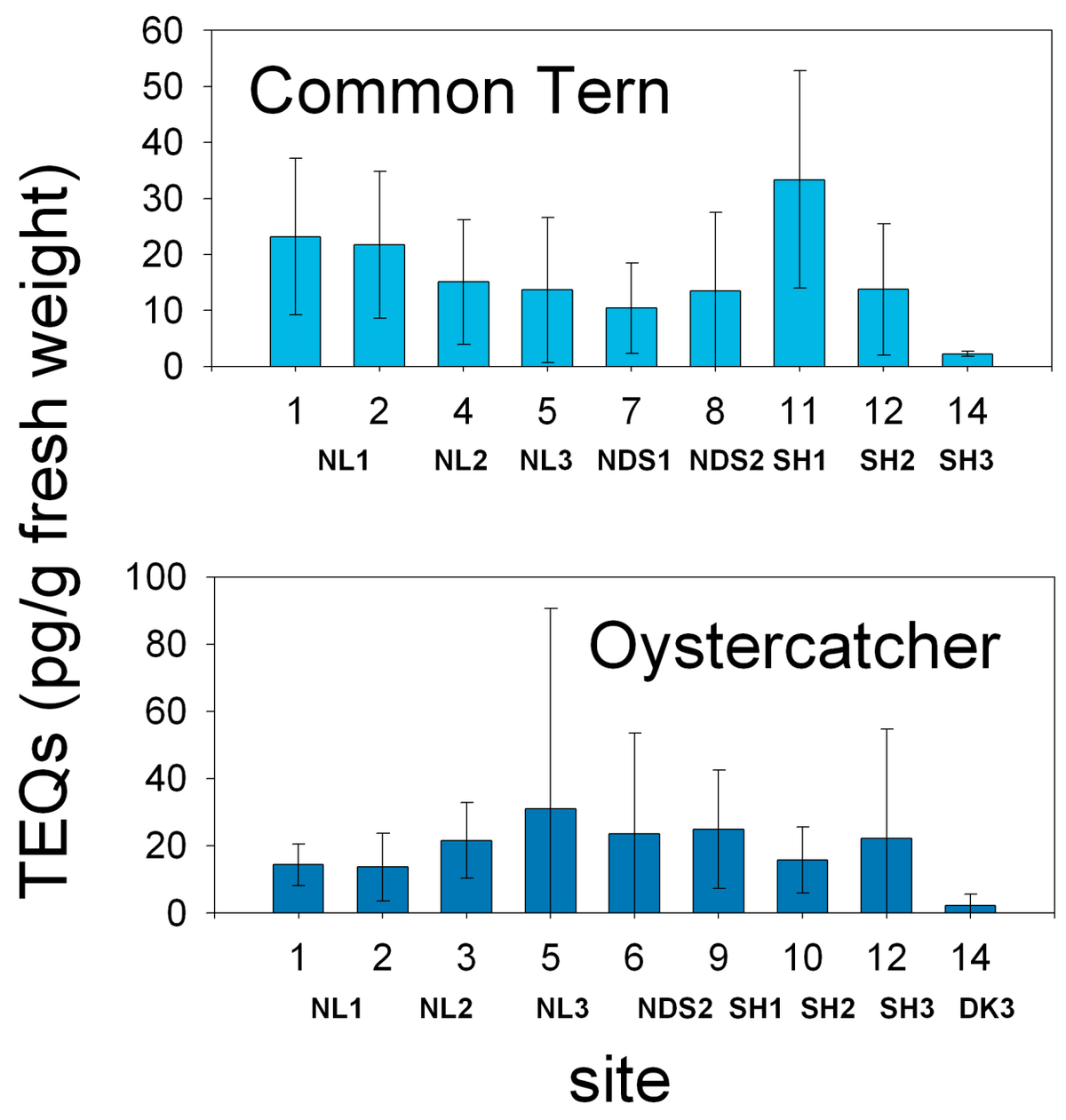 Figure 6. Geographical variation of TEQs (Toxic Equivalents) analysed in common tern and oystercatcher eggs in the Wadden Sea in 2015. To calculate TEQs of non- and mono-ortho PCB congeners, bird-specific 2,3,7,8-TCDD toxic equivalency factors (TEF) proposed by the WHO (Van den Berg et al. 1998) were used. Non-ortho congeners detected were PCB126 and 169, mono-ortho congeners were PCB105, 114, 118, 123, 156, 157, 167 and 189). Mean concentration (pg/g fresh weight of egg content) and 95 % confidence intervals are presented. At all sites ten eggs were sampled.
Figure 6. Geographical variation of TEQs (Toxic Equivalents) analysed in common tern and oystercatcher eggs in the Wadden Sea in 2015. To calculate TEQs of non- and mono-ortho PCB congeners, bird-specific 2,3,7,8-TCDD toxic equivalency factors (TEF) proposed by the WHO (Van den Berg et al. 1998) were used. Non-ortho congeners detected were PCB126 and 169, mono-ortho congeners were PCB105, 114, 118, 123, 156, 157, 167 and 189). Mean concentration (pg/g fresh weight of egg content) and 95 % confidence intervals are presented. At all sites ten eggs were sampled.
3. Assessment
Ecological Quality Objectives (EcoQOs) were defined by OSPAR for coastal bird eggs from the North Sea area (ICES 2003, 2004; OSPAR, 2007; Dittmann et al., 2012). In 2015 for common tern eggs the limit values of Hg (160 ng/g), PCB (20 ng/g), HCB (2 ng/g) and DDT (10 ng/g) were exceeded at all investigated areas, while limit values of HCH (2 ng/g) were exceeded in two areas. For the oystercatcher eggs the limit values of Hg (100 ng/g) were below limit values at two places only which was the case for HCH (2 ng/g) and HCB (2 ng/g) in three areas each. However, PCB (20 ng/g) and DDT (10 ng/g) concentrations exceeded the EcoQO levels at all places. These results underline that the target aims defined by OSPAR are not met anywhere.
The stagnation of the levels of various substances and some recent increases point to local problems with environmental pollutants. Among these are several contaminants the use of which was prohibited a long time ago, such as ΣDDT and ΣChlordane. At the hot spots of contamination, the present concentrations of ΣPCB and ΣDDT, especially in the eggs of common tern, are still very high in comparison with the target levels. But the concentrations of contaminants measured in bird eggs indicate that the burden of pollutants in the Wadden Sea is slowly decreasing towards the proposed Wadden Sea Plan Targets, which are background concentrations of micropollutants such as mercury which also occur naturally, and zero in case of man-made substances such as organochlorines (TMAP, 1997)
In the framework of a pilot study on the EcoQO “Mercury and Organohalogens in Seabird Eggs”, eggs were sampled at additional sites along the North Sea coast in 2008/2009 (Norway: Rogaland, Sweden: Skagerrak, The Netherlands: Rhine-Scheldt estuary, Belgium: Zeebrugge, and in 2009 at three sites in the UK). The inter-site comparison of contamination levels indicates that in most cases concentrations were lowest in the proposed reference areas in Scandinavia, far distant from industrial hot spots. The tentative EcoQO of mercury (≤200 ng/g in the common tern and ≤100 ng/g in the oystercatcher, based on lowest values ever measured in the Wadden Sea) was reached in oystercatcher eggs at Rogaland (97 ng/g) as well as in Arctic/ common tern eggs at Rogaland and Skagerrak, respectively (173 ng/g). Nevertheless, the lowest ΣPCB-levels found (Rogaland: oystercatcher 132 ng/g, Arctic Tern 137 ng/g) were still clearly higher than the target level of 20 ng/g.
Monitoring of breeding bird success, as well as population trends of breeding birds in the Wadden Sea are now part of the TMAP Common Package (Thorup & Koffijberg, 2016) (Koffijberg et al., 2015). Information on potential differences in the hatching success of coastal birds in areas with high and low contamination is now available, but has not yet been analysed. Muñoz Cifuentes (2004) presented data from the mid-1990s suggesting that the reproductive success of common tern, common gull (Larus canus) and herring gull (Larus argentatus) was negatively affected by organochlorine contamination in the lower Elbe. The current levels of most contaminants in bird eggs, however, are below the known threshold concentrations affecting birds’ reproduction.
Despite this, both species, common tern and oystercatcher, have a declining population trend in the Wadden Sea (Koffijberg et al., 2015) and a very poor breeding success (Thorup & Koffijberg, 2016).
4. Recommendations
Considering the current contamination status of bird eggs on the Wadden Sea coast and its recent development, it is recommended to:
- Continue monitoring the TMAP parameter “Contaminants in Bird Eggs” in a long-term perspective, especially at the identified hot spots, and on an annual basis in order to be able to have the statistical power to separate short-term fluctuations from long-term trends and to use the parameter for early warning of marine pollution with chemicals;
- Include new toxic substances such as hormone-active components;
- Continue to pursue the one-lab-approach, which has since 1991 been the basis for measuring the parameter “Contaminants in Birds Eggs”, saving costs and time;
- Continue assessment of the EcoQO “Mercury and Organohalogens in Seabird Eggs” (OSPAR 2007) in order to supplement the geographical coverage of “Contaminants in Bird Eggs” by additional sampling sites and reference areas around the North Sea;
- Combine the TMAP parameter “Breeding Success”, as a sensitive ecotoxicological indicator, with the parameter “Contaminants in bird eggs “, at least at the hotspots of chemical pollution (Elbe and Ems estuaries). The combination of both parameters will present an effective early warning system for chemical pollution of the Wadden Sea (Thyen et al., 1998; Muñoz Cifuentes, 2004).
5. Summary
The results from 2015 indicate similar species-specific spatial contamination patterns as in the previous years. The Elbe is again the most prominent site of contamination as regards the common tern, while for the oystercatcher particularly high concentrations of HCB were found at Delfzijl. In oystercatcher eggs, the spatial contamination peaks as well as the total burden of environmental chemicals were lower than in the eggs of the common tern.
When comparing 2015 with the previous year, both species showed a higher Hg burden in their eggs. By contrast the HCB concentrations were lower in 2015 after a steady increase in the previous years (Becker et al., 2001; Mattig et al., 2014). But in general the concentrations of the measured environmental chemicals in 2015 were of a comparable level to those of 2014. Our data show that the contamination levels in the eggs of the two species remained at a higher level after a constant increase until 2011/2012. The data presented in the last QSR (2009) showed sporadic and partly local events of increased contamination with some substances since 2004, whereas now stable or sinking levels were presented.
Compared with the contamination levels in these two species 35 years ago, there has been a clear decrease, mainly in the 1990s. But it is still unclear whether the contamination level of the environmental chemicals in birds is still changing or only shows fluctuations around established levels (cf. Becker & Dittmann, 2009) Even the data from 2015 did not provide a final answer to this question. This is also of interest against the background of the Ecological Quality Objectives (EcoQOs) defined by OSPAR for coastal bird eggs from the North Sea area (Dittmann et al., 2012). For the common tern eggs the limit values of Hg, PCB, HCB and DDT were exceeded at all investigated areas in 2015. For the oystercatcher eggs the limit values of Hg were below the limit values at two places only, while this was the case for HCH and HCB in three areas each. However, the results of PCB and DDT exceeded the EcoQO levels in all places. These results underline that the target aims defined by OSPAR are not met anywhere.
About the authorF. R. Mattig Carl von Ossietzky Universität Oldenburg, Department of Chemistry and Biology of the Marine Environment (ICBM), Schleusenstraße 1, 26382 Wilhelmshaven, DE |
AcknowledgementMany thanks to the National Park Agency Lower Saxony and Schleswig-Holstein, to NERI (DK), Rijkwaterstaat (NL), to CWSS and to all the volunteer helpers in the field. |
References
Becker P.H. & Dittmann T. (2009) Contaminants in dird eggs. Thematic Report No. 5.2. In: Marencic H. & de Vlas J. (Eds.). Quality Status Report 2009. Wadden Sea Ecosystem No. 25. Common Wadden Sea Secretariat, Trilateral Monitoring and Assessment Group, Wilhelmshaven, Germany.
Becker P.H. & T. Dittmann (2010) “Contaminants in bird eggs” in the Wadden Sea: Trends and Perspectives. Proc. 12th Intern. Scientific Wadden Sea Symposium, Wilhelmshaven. Common Wadden Sea Secretariat, Wilhelmshaven, Germany.
Becker P.H. & Muñoz Cifuentes J.M. (2004) Contaminants in birds eggs: recent spatial and temporal trends. In: Wadden Sea Ecosystem No. 18. Common Wadden Sea Secretariat, Wilhelmshaven.
Becker P.H. & Muñoz Cifuentes J.M. (2005) Contaminants in birds eggs. In: Essink K., Dettmann C., Farke H., Laursen K., Lüerßen G., Marencic H. & Wiersinga W. (Eds.) Wadden Sea Quality Status Report 2004. Wadden Sea Ecosystem No. 19. Trilateral Monitoring and Assessment Group, Common Wadden Sea Secretariat, Wilhelmshaven, Germany: 123-128.
Becker P.H., Koepff C., Heidmann W.A. & Büth A. (1991) Schadstoffmonitoring mit Seevögeln. Forschungsbericht UBA-FB 91-081, TEXTE 2/92, Umweltbundesamt, Berlin.
Becker P.H., Schuhmann S. & Koepff C. (1993) Hatching failure in common terns (Sterna hirundo) in relation to environmental chemicals. Environ. Pollut. 79: 207-213.
Becker P.H., Heidmann W.A., Büthe A., Frank D. & Koepff C. (1992) Umweltchemikalien in Eiern von Brutvögeln der deutschen Nordseeküste: Trends 1981 – 1990. J. Ornithol. 133: 109-124.
Becker P.H., Munoz Cifuentes J., Behrends B. & Schmieder K.R. (2001) Contaminants in bird eggs in the Wadden Sea. Temporal and spatial trends 1991 – 2000. Wadden Sea Ecosystem No. 11. Common Wadden Sea Secretariat.
Dittmann T., Becker P.H., Bakker J., Bignert A., Nyberg E., Pereira M.G., Pijanowska U., Shore R., Stienen E., Toft G.O. & Marencic H. (2012) Large-scale spatial pollution patterns around the North Sea indicated by costal bird eggs within an EcoQO programme. Environ. Sci. Pollut. Res. 19: 4060-4072.
Chemisches und Veterinärmedizinisches Untersuchungsamt Freiburg (2006) Statusbericht zu Dioxin in Eiern.
ICES (2003) Ecological Quality Objectives. ICES 2003ACE Report
ICES (2004) Ecological Quality Objectives. ICES Advice 2004, ACFM/ACE Report
Eggens M.L. & Bakker J.F. (2001) Toxicity of dredged material polluted with hexachlorbenzene (HCB) – is there a risk for organisms living in the Ems-Dollard Estuary? Wadden Sea Newsletter 24: 13-15.
Goutner V., Bakaloudis D.E., Papakosta M.A., Vlachos C.G., Mattig F.R., Pijanowska U. & Becker P.H. (2015) Organochlorine and mercury residues in eggs of the lesser kestrel (Falco naumanni) from a long term study in the eastern Mediterranean. Environmental Pollution 207, 196-204
Koffijberg K., Laursen K., Hälterlein B., Reichert G., Frikke J. & Soldaat L. (2015) Trends of Breeding Birds in the Wadden Sea 1991 - 2013. Wadden Sea Ecosystem No. 35. Common Wadden Sea Secretariat, Joint Monitoring Group of Breeding Birds in the Wadden Sea, Wilhelmshaven, Germany
Mattig F. R. (1998) Die Bedeutung von Umweltchemikalien im Lebenszyklus von Watvögeln am Beispiel des Alpenstrandläufer (Calidris alpina alpina). Berlin.
Mattig F.R., Rösner H.-U., Gießing K. & Becker P.H. (2000) Umweltchemikalien in Eiern des Alpenstrandläufers (Calidris alpina) aus Nordnorwegen im Vergleich zu Eiern von Brutvogelarten des Wattenmeeres. J. Ornithol. 141: 361-369.
Mattig F.R., Pijanowska U. & Becker P.H. (2014) Thirty-two years of Monitoring Pollutants with Seabirds in the Wadden Sea. Wader Study Group Bull 121 (2): 70
Muñoz Cifuentes J. (2004) Seabirds at risk? Effects of environmental chemicals on reproductive success and mass growth of seabirds breeding at the Wadden Sea in the mid 1990s. In: Wadden Sea Ecosystem No. 18. Common Wadden Sea Secretariat, Wilhelmshaven.
OSPAR (1997) Oslo and Paris Conventions for the Prevention of Marine Pollution. Joint meeting of the Oslo and Paris Commissions, Brussels 2-5 September 1997. Summary record OSPAR 97/15/1
OSPAR (2007). Background document on the EcoQO on mercury and organohalogens in seabird eggs. OSPAR Commission, Assessment and Monitoring series, No. 331.
Sommer U., Schmieder K.R. & Becker P.H. (1997) Untersuchung von Seevogeleiern auf chlorierte Pestizide, PCB’s und Quecksilber. BIOforum 20 (3/97): 68-72.
Thorup O. & Koffijberg K. (2016) Breeding success in the Wadden Sea 2009-2012 A review. Ecosystem No. 36. Common Wadden Sea Secretariat, Wilhelmshaven, Germany.
Thyen S., Becker P.H., Exo K.-M., Hälterlein B., Hötker H. & Südbeck P. (1998) Monitoring breeding success of coastal birds. Final Report of the Pilot Study 1996-1997. Wadden Sea Ecosystem 8. Common Wadden Sea Secreariat, Wilhelmshaven: 7-55.
TMAP (1997) TMAP Manual. The Trilateral Monitoring and Assessment Program (TMAP). Common Wadden Sea Secretariat, Wilhelmshaven.
van den Berg M., Birnbaum L., Bosveld A.T.C., Brunström B., Cook P., Feeley M. Giesy J.P., Hanberg A., Hasegawa R., Kennedy S.W., Kubiak T., Larsen J.C., Rolaf van Leeuwen F.X., Liem A.K.D., Nolt C., Peterson R.E., Poellinger L., Safe S., Schrenk D., Tillit D., Tysklind M., Younes M., Waern F. & Zacharewski T. (1998) Toxic equivalency factors (TEFs) for PCBs, PCDDs, PCDFs for humans and wildlife. Environ. Health Perspect. 106(12): 775-792.
Verein Deutscher Ingenieure (VDI) (2009) VDI Richtlinien – Biological procedures to determine effects of air pollutants (bioindication). Biomonitoring with bird eggs as accumulative and reactive indicators. VDI 4230, Part 3. Verein Deutscher Ingenieure, Düsseldorf.
This report should be cited as: Mattig F.R. (2017) Contaminants in bird eggs. In: Wadden Sea Quality Status Report 2017. Eds.: Kloepper S. et al., Common Wadden Sea Secretariat, Wilhelmshaven, Germany. Last updated 21.12.2017. Downloaded DD.MM.YYYY. qsr.waddensea-worldheritage.org/reports/contaminants-in-bird-eggs

